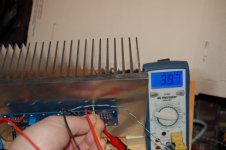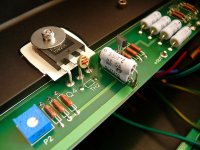Some builders have peeled the mica into four pieces with a razor blade to make thinner insulators trying to get more heat transfering into the heatsink.
That was what I was told to do recently as well. A short time ago someone brought up in another thread about an auction seller with appropriate sized mica insulators. I and several other members bough this items in bundles of 50, but were told what the ideal thickness was, and the pieces we had needed to be quartered to the appropriate thickness.
I have absolutlely no idea whether or not this is normal or not with mica insulators, I have never used them before. Now I am going to have to find the thread about those things! Surely this was an anomaly to these particular insulators?
Russellc
Last edited:
I havent re read yet, if its 50C for the heatsink, then that's great. I have a batch of Kerafol on the way, they are supposed to help a little in this regard. I would love to use this sink. What a bargain it is!
Russellc
Russell, that was a quote from Pass
woody clearly stated 37-38 degr heatsink, and 62degr mosfet casing
Woody, maybe your room temperature is low
on a hot summers day it gets really HOT
heatsink gets increasingly less and less effective with rising temperature
your heatsink is at 38 degr, and mosfet is at 62 degr
thats a 24 degr difference
if your heatsink gets really hot, on a hot summers day
and count in the lower efficiency at higher temperatures
then you might get really hot mosfet casing
whether it indicates problems with heat transfer or not, I dont kow
I think its great you do what you do, really
but it needs more verification to become reliable facts
but it needs more verification to become reliable facts
thing is these ARE facts ! yes it's spring here . 65/66f inside . will get hotter before the ac kicks in however these are the facts . REAL FACTS !!!
not computer simulations of sorta similar heatsinks .
i actually posted real facts . OMG
thing is these ARE facts ! yes it's spring here . 65/66f inside . will get hotter before the ac kicks in however these are the facts . REAL FACTS !!!
not computer simulations of sorta similar heatsinks .
i actually posted real facts . OMG
It does seem like a large difference between the devices and the heatsinks. I'm wondering if you couldn't reduce it by a few degrees.
Thanks you for sharing your experimental results.
To measure the MOSFET case temperature accurately, you need to measure at the metal part of the TOP3/TO247 MOSFET package (the drain), with e.g. a thermocouple. For 2SK1530/2SJ201, it is a bit more tricky, and you need to actually measure at the drain connection itself, without shorting the MOSFET of course, using e.g. a thermocouple. You will most likely notice a few degrees higher at the MOSFET case than the bolt, depending on the type of insulator used.
From the case temperature, and knowing the Rthjc from the datasheet (or derating curve) and the dissipation, you can calculate the junction temperature, which is the determining factor for transistor reliability. See the link in post #22.
No, I have not done the measurement using your type of HeatsinkUSA sink.
But I have done enough measurement of temperature maps of various Class A amps that I built over the years.
So far they agreed to simulated figures to within +/- 2°C (or +/-5%).
Best regards,
Patrick
.
To measure the MOSFET case temperature accurately, you need to measure at the metal part of the TOP3/TO247 MOSFET package (the drain), with e.g. a thermocouple. For 2SK1530/2SJ201, it is a bit more tricky, and you need to actually measure at the drain connection itself, without shorting the MOSFET of course, using e.g. a thermocouple. You will most likely notice a few degrees higher at the MOSFET case than the bolt, depending on the type of insulator used.
From the case temperature, and knowing the Rthjc from the datasheet (or derating curve) and the dissipation, you can calculate the junction temperature, which is the determining factor for transistor reliability. See the link in post #22.
No, I have not done the measurement using your type of HeatsinkUSA sink.
But I have done enough measurement of temperature maps of various Class A amps that I built over the years.
So far they agreed to simulated figures to within +/- 2°C (or +/-5%).
Best regards,
Patrick
.
Last edited:
> your heatsink is at 38 degr, and mosfet is at 62 degr
> thats a 24 degr difference
I would speculate that the heatsink temperature right next to the MOSFETs to be around 50°C.
i.e. Mica & Goop is responsible for about 10°C temperature difference.
For localised heat sources as in this test setup, 10°C temperature variation over the heatsink is not unusual.
Patrick
> thats a 24 degr difference
I would speculate that the heatsink temperature right next to the MOSFETs to be around 50°C.
i.e. Mica & Goop is responsible for about 10°C temperature difference.
For localised heat sources as in this test setup, 10°C temperature variation over the heatsink is not unusual.
Patrick
I would speculate that the heatsink temperature right next to the MOSFETs to be around 50°C.
i.e. Mica & Goop is responsible for about 10°C temperature difference.
For localised heat sources as in this test setup, 10°C temperature variation over the heatsink is not unusual.
just for the record
woody clearly stated temperature measured at a point 2" above mosfet
measure value 37-38 degr
woody, it is obviously a fact for your F5
but it doesnt make it a general fact
I'm quite sure most other builders will measure higher temperatures
40 degr, you can probably keep your hand on that forever
its classA and expected to be too hot to touch
Attachments
There are three important temperatures to define the reliability and safety of the SS amplifier.
Tj, the temperature of the junction/substrate.
Tc, the temperature of the case at the interface with the cooler.
Ts, the temperature of the heatsink that can be touched.
I consider Tj and Tc to be a design issue.
These must be operationally satisfactory for the amplifier to work !!
Ts is a builder issue.
Which parts of the sink can be touched? What are the temperatures of the parts that can be touched? What are the internal temperatures? Will other components cook?
Tj, the temperature of the junction/substrate.
Tc, the temperature of the case at the interface with the cooler.
Ts, the temperature of the heatsink that can be touched.
I consider Tj and Tc to be a design issue.
These must be operationally satisfactory for the amplifier to work !!
Ts is a builder issue.
Which parts of the sink can be touched? What are the temperatures of the parts that can be touched? What are the internal temperatures? Will other components cook?
k , awesome corned beef (burp) , it's been running close to 4 hours and after it stabilized i biased it at .60v . rails are @23v
i could leave my hand on it all day .
the mosfets are mounted with silicon heatsink compound and keystone micas .
the input is shorted .
am i missing something ? hey i'm new at this and learning , any input appreciated .
cheers Woody
Woody--see my F5 build, under the "beautiful music, different drummer" thread. I have pretty well duplicated your results. Running Conrad heatsinks, 0.6v bias, and after a long soak (three hours), my heatsinks are entirely "comfortable". No detailed temp measurements, but I'd estimate about 40C. In fact, my basement workshop is cool, and the heatsinks were welcome "handwarmers". Right now, I effectively have bare heatsinks, with small very low-speed muffin fans passing ambient air against the base (unfinned) portion of the heatsinks. Probably will not need the fans, even after I complete the amp case. See my thread, for more details.
Thanks you for sharing your experimental results.
To measure the MOSFET case temperature accurately, you need to measure at the metal part of the TOP3/TO247 MOSFET package (the drain), with e.g. a thermocouple. For 2SK1530/2SJ201, it is a bit more tricky, and you need to actually measure at the drain connection itself, without shorting the MOSFET of course, using e.g. a thermocouple. You will most likely notice a few degrees higher at the MOSFET case than the bolt, depending on the type of insulator used.
From the case temperature, and knowing the Rthjc from the datasheet (or derating curve) and the dissipation, you can calculate the junction temperature, which is the determining factor for transistor reliability. See the link in post #22.
No, I have not done the measurement using your type of HeatsinkUSA sink.
But I have done enough measurement of temperature maps of various Class A amps that I built over the years.
So far they agreed to simulated figures to within +/- 2°C (or +/-5%).
Best regards,
Patrick
.
Sorry to revive an old thread but I was looking up info on the heatsinkusa 10.08" heatsinks for an F5 and I noticed this comment. In the documented builds I noticed everyone pushes their thermistors onto the case but looking at a photo of the F5 from 6moons it looks like Pass is measuring temp from the center lead (touching? or just very close with a slight gap?) Anyone know if there truly is a difference? Thanks.
Attachments
..... if there truly is a difference? ...
no
- Status
- This old topic is closed. If you want to reopen this topic, contact a moderator using the "Report Post" button.
- Home
- Amplifiers
- Pass Labs
- F-5 heatsink query

